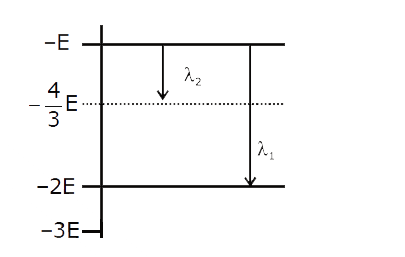Two protons are having same kinetic energy. One proton enters a uniform magnetic field at right angles ot it. Second proton enters a uniform electric field in the direction of field. After some time their de Broglie wavelengths are λ1andλ2 then (a) λ1=λ2 (b) λ1<λ2 (c) λ1>λ2 (d) some more information is required
λ1=λ2
λ1=λ2
λ1<λ2
Depends on direction of electric field
The correct Answer is:D
In magnetic field, velocity of the electron doesn't change. But in electric field, velocity may increase or decreases depends on direction of electric fiels
Topper's Solved these Questions
Similar Questions
If the two roots of the equation (λ−2)(x2+x+1)2−(λ+2)(x4+x2+1) are real and equal for λ=λ1,λ2 then λ1+λ2=0 (b) |λ1−λ2|=6 (c) λ1+λ2=32 (d) all of these
View SolutionLet be the maximum kinetic energy of photoelectrons emitted by light of wavelength λ1 and λ2 correspondingto wavelength λ2. If λ1=2λ2 then:
View Solution
Knowledge Check
- Question 1 - Select One
Two electrons are moving with the same speed v. One electron enters a region of uniform electric field while the other enters a region of uniform magnetic field,then after sometime if the de-Broglie wavelenths of the two are λ1 and λ2 then :
Aλ1=λ2Bλ1>λ2Cλ1<λ2Dλ1>λ2 or λ1<λ2 - Question 2 - Select One
A proton and an electron are accelerated by same potential difference have de-Broglie wavelength λp and λe .
Aλe=λpBλc<λpCλe>λpDnone of these - Question 3 - Select One
The wavelength of electron waves in two orbits (λ1:λ2)
A25:9B5:3C9:25D3:5
An electron, a doubly ionized helium ion (He++) and a proton are having the same kinetic energy . The relation between their respectively de-Broglie wavelengths λe,λHe++ and λp is :
View SolutionSome energy levels of a molecule are shown in the figure. The ratio of the wavelengths r=λ1/λ2 is given by -
 View Solution
View SolutionA dye absorbs a photon of wavelength λ and re− emits the same energy into two phorons of wavelengths λ1 and λ2 respectively. The wavelength λ is related with λ1 and λ2 as :
View SolutionTwo sound waves of wavelengths λ1 and λ2(λ2>λ1) produces nbeats/s , the speed of sound is
View SolutionFor balmer series wavelength of first line is λ1 and for brackett series wavelength of first line is λ2 then λ1λ2 is
View Solution

